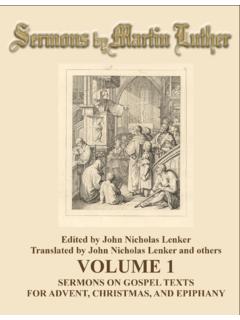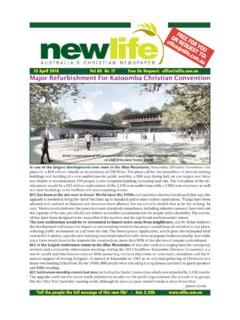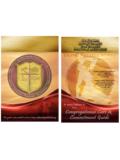Transcription of LOCHORE CASTLE AND BALLINGRY. - BHPG
1 LOCHORE CASTLE AND ballingry . The chief antiquarian interest in the parish of ballingry centres in LOCHORE property, now possessed by Lady Scott, the daughter-in-law of Sir Walter Scott, the novelist and poet. Niece of the late Sir Adam Fergusson, Lady Scott (then Miss Jobson) was present at a grand ball given at Abbots-ford during the Christmas of 1824, and Captain Hall, one of the guests on the occasion, cursorily characterises her as "the pretty heiress of LOCHORE ." She was married in the spring of 1825 to Sir Walter's eldest son, who died from the effects of a tiger-hunt in 1847. Sir Walter Scott, whilst residing at LOCHORE House, seems to have heartily enjoyed his rambles in the vicinity, and to have obtained not a little antiquarian information regarding the Lochleven district from the late Mr Birrel, whom he describes as a "cheerful little old gentleman." The property was first named Inchgall, but in the thirteenth century it fell into the hands of the Lochores, a family of distinction hence its present name.
2 The lake called LOCHORE at one time covered a hundred acres, but about the end of last century it was drained by Captain Park, the proprietor, at a cost of nearly 1000. Being a natural reservoir, the loch furnished at all seasons a regular and sufficient supply of water to the mills on the Ore, and conse-quently the proprietors of them were materiallyI injured by the drainings. Towards the eastern ex-tremity of the loch was an island, upon which, about the year 1160, Duncan de LOCHORE built a CASTLE . The ruins of this feudal stronghold still remain upon what appears now to be a knoll. They consist of a square tower, with indications of many lower buildings, surrounded by portions of a wall, guarded at the cardinal points by four turrets, and enclosing an area of about two hundred yards circumference. Part of the square or keep is in a semi-state of preservation, measuring interiorly 23 feet by 16, and of about 40 feet in height. There is an entire window in the west gable, and narrow loopholes for hurling missiles at the enemy can still be seen.
3 The building seems to have been of great strength, the walls, roofless and crumbling with the storms of seven centuries, being nine feet thick. Seventeen old trees stand within the line of the outer fabric, and the CASTLE , now hoary and desolate, with the Ore sweeping past at its base, may have suggested to Scott, whilst sitting amid its ruins, some of the characters of his fictions. It is said to have formed a beautiful object situated, as we have mentioned, on an island of the lake, but the latter having, with much industry and skill, been drained, the beauty of the old CASTLE is greatly diminished. "Ages on ages, still against the tide Of ruthless searing Time, thy walls have stood : Bold as thy dauntless Barons, who subdued Stern foes of other days days of thy pride- When thy roof sheltered nobles. But no more Life echoes through thy casements, as of yore, When gaily dazzling in the light From gems, and jetting lamps on high, And lovers' glances darting bright, Thy chambers sparkled as a sky.
4 " The family of LOCHORE was of considerable importance in early times. In the reign of Alexander the Second, Adam de LOCHORE was sheriff of Perth. David de LOCHORE was in 1255 also sheriff. In 1289, Hugo de LOCHORE was Vicecsmes de Fife, as was Constantinus in 1292. David de LOCHORE was named in Ragman's Roll anno 1296. In 1315, Thomas de LOCHORE was one of the Parliament at Ayr which tailzied the crown on the heirs of Robert Bruce, and his seal was appended to that act. The property of LOCHORE afterwards passed successively into the hands of the Wardlaws of Torry (whose name was inscribed over the chief entry of the CASTLE ), the Rothes family, and the Malcolms of Balbedie, by whom it was sold to Captain Park. After one or two other changes, it was purchased by Mr Jobson, the father of the present Lady Scott. A little to the westward of LOCHORE House, are the remains of a Roman camp, in some places levelled and defaced, but still remarkably entire.
5 The form being nearly square, the total circumference is about 2020 feet; and there appear on the north and west sides three rows of ditches, and as many ramparts of earth and stone. There was once a turret on the side next the CASTLE . This is supposed to be the spot mentioned by Tacitus where, during Agricola's invasion of Fife, in the year 83, the Ninth Legion sustained a severe discomfiture by the Caledonians. That Roman invader marched one of the divisions of his army to LOCHORE , two miles south from Lochleven, having Cleish Hills on the left, and Benarty Hill on the right. Sir Walter Scott, in a playful, genial letter to Lady Scott then newly married to his eldest son throws out a few antiquarian hints anent the locality, referring to the Caledonians as rushing down from Benarty and almost entirely destroying the whole Ninth Legion. Under the soil where the loch was, there have been found, at different times, a cannon ball, a silver spoon, and a marble slab, from which latter a draught-board has lately been made.
6 Benarty Hill is situated on the southern bank of Lochleven, and commands a delightful and extensive prospect. At its base, in a fertile valley, nestles the village of ballingry , popularly pronounced Bingry, The Rev. James Pennell has held the living here of which Lady Scott is the patroness since 1857. The church, which is a neat building, was built in 1831. It is seated for 320. The heritors, with much foresight, built a larger place of worship than was then absolutely necessary. The spare pews were soon occupied by the parishioners of outlying districts, and now that Lumphinnans is placed in the new quoad sacra parish of Lochgelly, the pews belonging to farms in that district are being occupied by the miners, who, now that the mineral resources of the parish are being opened up, are pressing into the old parish. There are about 150 communicants. Besides Bible classes in connection with the congregation, there are three district Sunday schools, and at the places where these assemble meetings for adults are in rotation held by Mr Pennell.
7 The parish teacher is Mr A. T. Keppie, who also holds the appointments of registrar and inspector of poor. ballingry is one of the oldest parishes in Scot-land. It was a rectory in the old Roman Catholic times, and it is recorded that in the year 1594 there was a vicar in the parish. The present belfry is the same which was placed over the Roman Catholic parish church ; the communion plate, which is very handsome, is two hundred years old ; and the communion linen is considerably older. The very pleasant atmosphere of the place seems to have affected successful incumbents. Bishops might come and go, but they remained ministers of ballingry . At the revolution, however, Mr Henry Malcolm, the Episcopalian incumbent, retired to Cupar. He possessed a large manuscript volume of the antiquities of the district, referred to by David M'Pherson, Esq., editor of Wyntoune. The discipline of the old church sessions appears to have been stern and impartial even lairds had to stand as penitents for three successive Sabbaths in a sort of pillory at the church door.
8 Mr Greig, a later minister, used to rebuke in the church within living memory. Dr Hardy, afterwards of the High Church, Edinburgh, and a Professor there, was at one time proprietor of Navity and minister of ballingry . He suggested a plan for the modification of church patronage not unlike what is at present proposed. Dr Wallace, latterly minister of Whitekirk and Moderator of the General Assembly, also held the living for a time. His old housekeeper, who removed with him, was true to the last to the old parish and "the Kingdom" amid all the beauties and allurements of Whitekirk. When any one spoke to her of the scenery of that neighbourhood, she was wont to say, " Oh, the place is weel eneuch, but it's no like Bonnie Bingry." The Rev. James Greig, whose memory lingers in the parish as a good, simple-minded, faithful pastor, was for near half a century minister of ballingry . He used to say, in his homely way, that when he came to the parish there were only '' seventy reekin' lums "in it all.
9 Of that worthy minister of the old school, it might well be said " Bemote from towns, He ran his godly race, , And ne'er had changed Nor wished to change his place." Life went on very smoothly with the good man, but he and in Bingry even had his little troubles. He preached without "the paper," and was easily disturbed in preaching. On one occasion, an intrusive hen appeared in the church to the great delight of the juniors of the congregation. "Take out that hen or male fowl," were the stern accents of the conscientious, but perturbed, minister. On another occasion, when in the very heat of his sermon, a strange dog appeared. " Take out that dog," said the minister. " 'Deed, sir," responded the beadle (a character, of eourse), " if I had a guid stick I wud mak him gan oot on his ain feet." The worthy minister's little weaknesses, too, were " known to all the country round." He was very much afraid of thunder, and various anecdotes are still told of this.
10 He also had a most orthodox hatred of popery, and when a lady mildly suggested when the new church was being erected that he should have the pulpit covered with red cloth, he replied, " I should be sorry, madam, to mention in your presence of what lady red is the emblem." When his old patron died, and the property was sold, Mr Greig entered into a long litigation about the teinds of the parish, and at length found himself in the House of Lords. He wrote to the Lord Chancellor of the day, and mentioned that he would let the papers speak for themselves, as he was afraid to risk more expense for counsel. That Chancellor was Lord Brougham, and he lost nothing in his hand. The case was ultimately decided in the minister's favour. In the parish of ballingry , more than is generally met with in any other, large numbers of stones are to be found. To account for this, tradition alleges that at one time (for dates in such matters are always nameless) the Deil was in the act of carrying from a certain place in the south a tremendous quantity of stones with which to fill up Lochleven, when, in skulking over this parish, Ms apron-string broke, and the whole of the stones were precipitated in Bingry !



